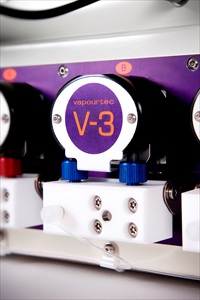Members Login

Channels
Special Offers & Promotions
Vapourtec Pump Key To Organometallic Process
A recent academic paper published in the journal Organic Process Research and Development by the Group of Prof Steven V. Ley, Department of Chemistry, University of Cambridge (UK) outlines a possible breakthrough for the manufacture of breast cancer drug Tamoxifen involving flow chemistry technology developed by UK specialist chemical engineering firm Vapourtec.
 A prominent feature in the success of the research carried out, profiled in the article “Continuous flow-processing of organometallic reagents using an advanced peristaltic pumping system and the telescoped flow synthesis of (E/Z)-tamoxifen”, was the use of Vapourtec’s E-Series flow chemistry system that enables the processing of organometallic reagents.
A prominent feature in the success of the research carried out, profiled in the article “Continuous flow-processing of organometallic reagents using an advanced peristaltic pumping system and the telescoped flow synthesis of (E/Z)-tamoxifen”, was the use of Vapourtec’s E-Series flow chemistry system that enables the processing of organometallic reagents.
The Ley Group paper describes a telescoped continuous flow process that produces Tamoxifen at the rate of one dose every 5 seconds.
In June 2013 the National Institute for Health and Care Excellence (NICE) recommended that Tamoxifen should be taken by “at-risk” groups of women because the drug can help prevent the contraction of breast cancer.
Specifically the newly developed Vapourtec V-3 pump, a chemically resistant peristaltic pumping system, is at the heart of a process which allows chemists to continually pump highly reactive substances which can permit the use of exciting reactive intermediates. The utility of such reactive chemicals were then harnessed to prepare Tamoxifen, a hormonal therapy used to treat breast cancer.
Existing approaches for pumping organometallic reagents, such as n-butyllithium, Grignard reagents and DIBAL-H, can present a number of challenges due to sensitivity to air and moisture, however, the V-3 pump eliminates these issues.
Based on the peristaltic principle, the V-3 has been designed so that it can deliver a smooth flow at up to 10 bar pressure and even self prime from pipes that are full of air.
The wetted area inside the V-3 pump is small and can be easily and rapidly dried using an anhydrous solvent. Reagents can be fed directly from a bottle sealed with a septum which eliminates the need to manually handle potential pyrophoric reagents.
The V-3 does not feature check valves or sliding seals which means that the occasional generation of suspended particles of insoluble salts, caused by small amounts of moisture, presents no problem to the process.
Dr Duncan Browne, an experienced post-doc and flow chemist involved in the research project in the Ley Group, Cambridge commented: “The V-3 pump has enabled us to expand previous flow chemical reactions into truly continuous processes that produce significant quantities of materials. The simplified pumping of organometallic species have allowed us to access reactions and reactivity that we have previously found difficult”
Andrew Mansfield, Applications Specialist with Vapourtec, explained: “This is a very important paper from CambridgeUniversity that reports on a significant breakthrough in flow chemistry with our E-series system, incorporating the V-3 pump, proving to be a critical component of the entire process”.
“This is a perfect example of how technological innovation in the field of flow chemistry can deliver more effective and efficiently manufactured solutions for a wide variety of industries, including pharmaceuticals,” concluded Andrew.
Media Partners


